Arrowhead Order – Public Interest is not within scope!
October 31st, 2005
But… but… I thought it was all connected!?!?!
The Commission finds that settlement between Douglas County and the applicants allowing the necessary easements resolves all of the issues in the reopened docket, since the docket was reopened for the limited purpose of considering alternate routes in Douglas County. In addition, whether this private agreement is equitable and in the interest of the intervenors and the public is not within the scope of this docket.

HUH? Last I checked it was the Public Service Commission!
Here’s the Order of the PSC in the Arrowhead case closing the docket. Download file Really, that’s what it says.
To look at the filings in the tail end of the Arrowhead Transmission Docket go to the PSC home page, and where it says “Quck Links for Utility Information” look below “Link Directly to a Case” and enter 05-CE-113 and you’ll get the last few hundred of the documents.
Here’s that Douglas County Agreement. Download file
Poor Mikey — ya gotta have coffee before my blog
October 30th, 2005
Hot off the press from Mike Bull, Assistant Commissioner for Renewable Energy and Advanced Technologies (I realize many don’t check comments, and of course he gets equal time!):

Good lord, Carol, relax! The technology does in fact turn coal into synthetic gas, which can be used to generate electricity — so its proven in that sense. Reliability of the gasifiers is an issue that will be very important going forward, so we don’t have the same level of comfort with this technology as we have with, say, coal combustion, so there is a good deal more uncertainty involved relative to conventional technologies. But, ultimately, if we’re going to continue to use coal as a fuel (and I think we are), conventional technologies are going to have to give way to coal gasification technologies.
“Relax…” I tell him, “Relax? RELAX???? Don’t you remember Che’s “constant motion and eternal vigilance?” Oh, but he’s dead… (read the Buckley book if you haven’t yet). I could bring up the Wellstone “stand up, keep fighting” but that’s so last week … And then there’s the Norwegian poet Arnulf Overland…
Some people apparently don’t want to look at the problems with coal gasification. Some say it’ll replace regular coal! Really? How will that happen? This is NEW generation in a greenfield, not replacement of old noxious coal. Some say the CO2 will be sequestered, but there’s no plan for that and no mandate! Even if there were, sequestration wrecks havoc on an aquifer.
Here’s from the Wabash Final Report, the most recent coal gasification plant:
Construction costs were twice what they expected
Wastewater was “routinely” in violation of the permit due to high levels of selenium, cyanide and arsenic, and the problem had not been corrected by the time of this report.
Plant had 36-38% efficiency factor – that’s regarded as GOOD!
Plant was out of service much of the demonstration time, towards end had 60% capacity factor. That’s 19% better than an NEG Micon wind turbine!
Yup, sounds like a good investment to me, especially one that the DOE defines as “risky” and where it’s the NRG folks driving this bus, the NRG that nearly drove Xcel to bankruptcy! Yup, sounds just like the project I want to give all the perks and freebies to! Oh, yeah, great idea. City, County, IRRRB, State, Feds, are we missing any donors here? Oh, each and every one of us taxpapers!!!
Ray Cox thinks coal gasification is proven — HA!!!!!!
October 30th, 2005
It’s so goofy when people pontificate about something they know nothing about.

Coal gasification, the technology of the Mesaba DEMONSTRATION project, is anything but proven. Even the DOE knows this, and states “DEMONSTRATION” in all their materials – -check the DOE’s NOI, which acknowledges the risk of this project and discusses the serious technological problems. Where does Ray get these crazy ideas? It’s like the guy at the Taconite meeting who was trying to say that it wasn’t a wetland — if he won’t believe his eyes, I wish he’d read the Notice of proposed Floodplain and Wetlands Involvement! Humans have such aversion to reality!
The most recent attempt at coal gasification was the Wabash River plant, where they repowered an old coal plant with a 262MW coal gasification DEMONSTRATION project.
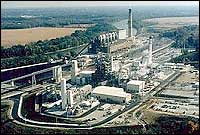
Imagine this nestled in the woods and bogs of the Range!
Mesaba and Wabash are DEMONSTRATION projects, deemed by the DOE as too risky for private development and which must be supported by grants and federally guaranteed loans.
Here’s the Wabash River Coal Gasification Repowering Project – Final Technical Report which will tell you all about the problem experienced.
Construction costs were twice what they expected
Wastewater was “routinely” in violation of the permit due to high levels of selenium, cyanide and arsenic, and the problem had not been corrected by the time of this report.
Plant had 36-38% efficiency factor – that’s regarded as GOOD!
Plant was out of service much of the demonstration time, towards end had 60% capacity factor. That’s 19% better than an NEG Micon wind turbine!
They often say that the plant was “unavailable” and it would be a tad bit more honest if they’d say that the plant was shut down because they couldn’t or didn’t pay their gas bill!
Here’s a couple more blurbs on Wabash:
Wabash River Coal Gasification Project: A DOE Assessment This report is from January 2002, after the “final” report.
Wabash River Coal Gasification Project: An Update This report is from September 2000, just after the “final” report.
Here’s the CCPI Public Abstract for Mesaba.
Here’s a handout from the meeting, Project Facts, Mesaba Energy Project.
Here’s a Power Point from October 2005! Excelsior Energy, Inc.: A CCPI Round 2 Project.
Coal gasification goes back a bit further, but not much in the way of projects. There have been very few over the last 30 years. In the 70’s, there were two STEAG plants in Europe, and following that, air blown and oxygen blown were compared with the STEAG plants, with the US plants winning out. The EPRI report on this was prepared by FLOUR, the Mesaba engineers on the project (see Economic Evaluation of GCC Power Plants based on the STEAG Combined-Cycle Design and Comparison With a U.S. Combined-Cycle-Based System, EPRI AF-1288; see also Economic Studies of Coal Gasification Combined Cycle Systems for Electric Power Generation, EPRI AF-642, Flour; An Economic Evaluation of MHD-Steam Powerplants Employing Coal Gasification, RI 7796, Bergman, Plants, Demeter & Bienstock).
Yup, Ray’s not the only one who hasn’t a clue, but that’s what happens when you don’t do your homework and rely on lobbyists — for this “Two Lobbyists and a Wife” project, that’s an obviously flawed approach!
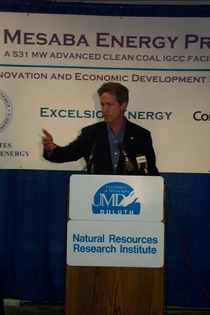
I feel another “Generation for Volt Dolts” coming on…
Mesaba – Comments on Scope of EIS due November 14
October 28th, 2005
Comments are due on the Scope of the EIS by November 14, 2005. Here’s the DOE’s Notice of Intent: Download file
Send to:
Richard Hargis
M/S 922-342C
U.S. DOE – NETL
P.O. Box 10940
Pittsburgh, PA 15236-0940Email to:
richard.hargis@netl.doe.gov
Fax to:
(412) 386-4775
I have to approach this project with humor, because it is so damn absurd that it went forward, and now that it’s going forward in a greenfield — what’s wrong with this picture. It’s so bizarre that those with the resources and who oppose coal plants were silent as the largest coal plant, the largest power plant of any type, in the history of Minnesota rolled through the legislature, and remain silent today. Is this the energy future we want?
Look again at this view of the coal train route on the other side of the lake! The plant would be way off to the left. This is the energy nightmare moving towards reality.
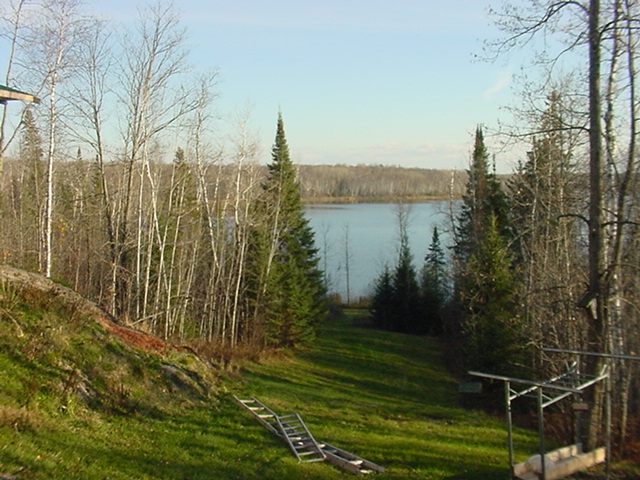
The site maps are here. They’re not on the Excelsior site. Click here to ask them to post information!
Here’s my notes from their Power Point — handouts on this project only go one way — I had to take pictures of them!
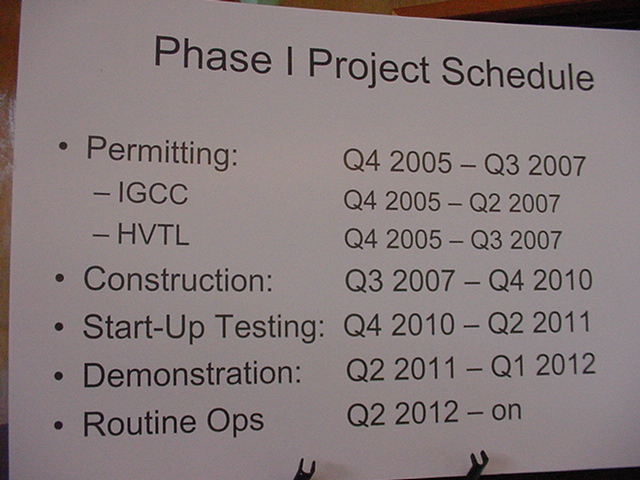
Phase II
Construction of Phase II IGCC power station overlaps
construction of Phase I station
* Resource requirements, emissions, effluents and byproducts
double in most instances
* 160-180 permanent, full-time staff (Phase I+II)
* Increased water demands
o Sufficient water supply must be demonstrated
o Use of additional water sources likely
* Commercial in-service planned for 2013Public Utilities Commission
* Phase I construction: Q3 2007 � Q4 2010
o 1,000 construction workers on-site at peak + vehicles
o 25 acres of land required for IGCC plant; additional 80
acres required for equipment laydown plus 5 acres for
concrete batch plant
* Phase I operation: Q4 2010 � onward
o 100-120 permanent full-time workers* Resources consumed & by-products generation: Estimated worse
case
o Coal 8,230 tons of coal per day: 4-5 round-trip unit train
trips per week
o Water 6,500 gallons per minute peak 4,500 gallons per
minute annual avg.
o Marketable byproducts: 500-800 tons/day slag; 30-160
tons/day elemental sulfur
o Materials for disposal: 2,200 tons/yr ZLO salts; 75 tons/yr
carbon
o Very low emissions of air pollutants, including mercury
___________ year)
* No discharge of process waters used to clean syngas on _______
* West Range site flood control
* Water used for evaporative cooling discharged to Holman Lake
(West Range)
* Four year search effort
* Criteria utilized to narrow list of potential sites
o Licensability
o Community support
o Sufficient water supply for Phase I & II developments
o Access to infrastructure sufficient to meet project needs
– Optional rail providers
– Existing corridors to reach major electric
substations(s)
o Site control
o Lake Superior Basin watershed
* Ongoing investigations
Note the above says “Lake Superior Basin watershed — this is not correct for the West Range – Taconite site — it’s in the Mississippi, where the Swan River and Mississippi are already listed as impaired. Check the PCA’s map!
Here’s the info from the meeting from the feds, called Mesaba Energy Project. Download file
Here’s the new map or site plan, note the green line between the two lakes — that’s new, a landowner discovered Co. Rd. 7 would be rerouted over his land at the meeting — no one had bothered to contact him.
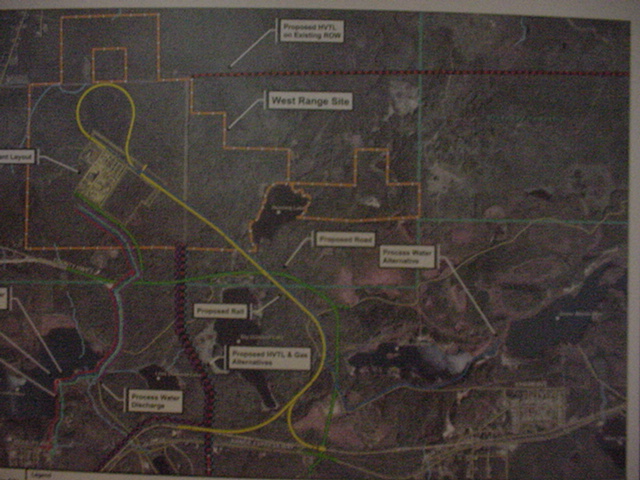
Here’s a drawing of what it might look like — remember, everything is preliminary and changable:

And here’s a more schematic view from above:
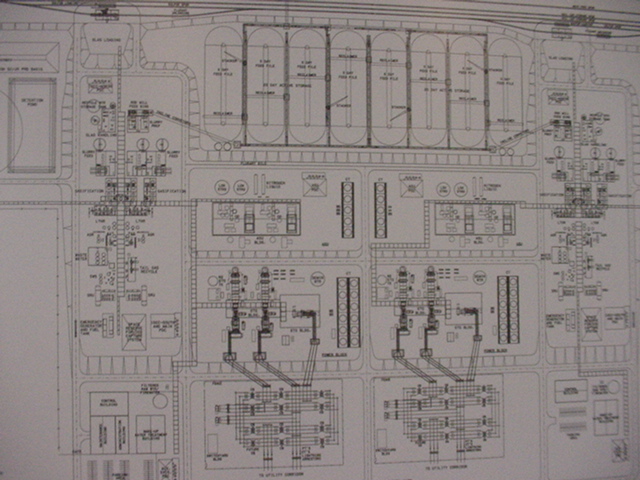
Here’s the DOE-Notice of Intent with more info on the project than we’ve ever received before: Download file
And I noticed a tie that should be clarified. Ron Dicklich, in his “we NEED this power,” “we’ll freeze in an incubator in the dark without a job” project stump speech, declared that he “works for GRE and Range Association of Municipalities and Schools,” but there’s more:
What he neglected to say was that he’s also promoting MSI, which is to be located in Nashwauk, and which is planned to share rail infrastructure with the Mesaba Project — and perhaps an electrical customer — can MSI be built without the ready supply of electricity? Here’s the info on the MSI tie that should have been disclosed:
MSI outlines $1/6 billion dollar project
MSI project moving forward
I hate it when people hide their vested interests…
This is the same Mesaba and MSI connection that Miles W. Lord is concerned about.
Micheletti & Overland near fisticuffs in the Hoyt Lakes Arena
October 27th, 2005
Oh, I’m in trouble now — Tom Micheletti says he won’t talk to me anymore, that’s after he threatened to drag me into the hockey rink and high stick my jaw into the next county! Pat’s still pouting because I wouldn’t risk breaking my camera at the first meeting… And there’s no dining room set or new deck chairs waiting here, but I’ll check the poopdeck again in the daylight. Looks like there’s no deal… sigh…
Hoyt Lakes was disappointing, very few folks showed up compared to Taconite. I’d guess it’s because it’s far less controversial in Hoyt Lakes, a Hoyt Lakes facility was what they’d bargained for, and instead Excelsior says Taconite. What will it take to get a legislative requirement that it be on a brownfield site with infrastructure?
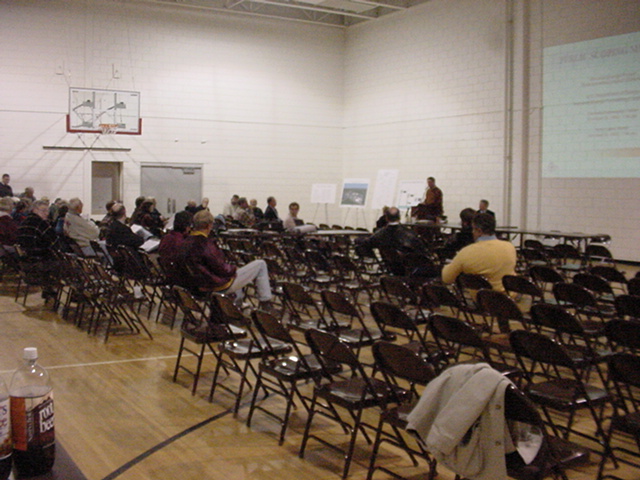
Rosie Loeffler, Duluth Clean Water Action, was there and made her verbal EIS Scoping Comments for the record, though I missed what she said because I was in the midst of another altercation in the foyer, this time with Tommy Rukavina, who is delightfully honest and pigheaded, and we had a few feisty words about … well, never mind… David Tomassoni, on the other hand, needed me to settle an issue with Ron Dicklich — Ron’s struck out and I’ve got a hat trick — this time he couldn’t remember when the Mesaba bill was passed! Plus he was all screwed up on Personal Property Tax and wanted to convince me, Tommy too, that Utility Personal Property Tax was eliminated in 2001 — here, Ron, read the Primer! Do your homework! And if you have questions, ask Mikey, he wrote it! If Personal Property Tax ist zu ende, what exactly were we doing with the Waseca power plant last session? Generation for Volt Dolts is another must read before you trot out any of those “freezing in the dark in an incubator without a job” sob stories.
On the way to Hoyt Lakes, I stopped by Big Diamond Lake to get a feel for the area. I found a view where I could see across the lake to the other side, where the train track would be — 4-5 round trips of 115 car train for the 8,000 tons of coal the plant would use, EACH DAY. So imagine sitting on the deck here and watching and listening to 1.5 miles of train 10 times daily.

Imagine if this were your home. The bait and switch nature of this project is just not right — it’s time to hold them accountable.
On the way over to Hoyt Lakes, it was an amazing fall day. I couldn’t resist — had to stop and turn around — this is what Northern Minnesota is all about:
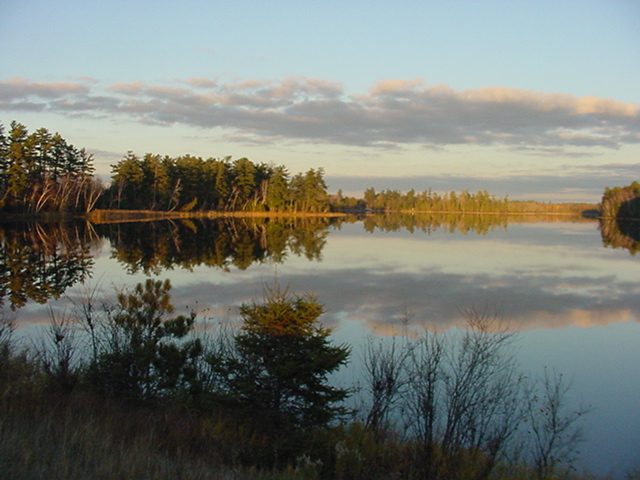
But these guys have another idea for the Range:
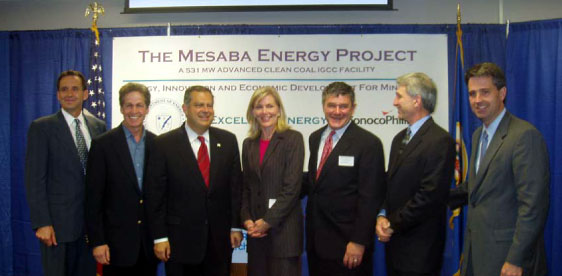
Tomorrow, when I can see straight, I’ll have the details on their proposal that were revealed in these meetings — it’s still sketchy, and it’s subject to change, but it’s more than we’ve ever had before.